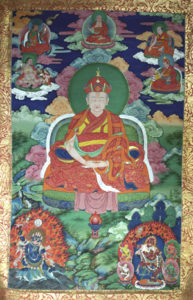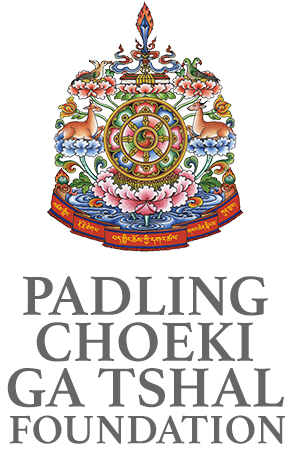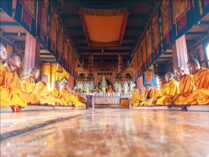
Gyalse Pema Thinley was son of Thukse Dawa Gyaltshen, who himself was the son of Terton Pema Lingpa and an emanation of Hayagriva (Tandrin). He was born amidst miraculous and auspicious signs in 1564 with extraordinary bodily marks. He was recognized as the true incarnation of Khenchen Tshultrim Paljor. His father Thukse Dawa Gyaltshen declared the young Truelku as the activity lineage holder of his own father, Terton Pema Lingpa, and appropriately named him Pema Thinley and conferred on him all the core teachings and instructions.
In addition to receiving teachings from his father, Gyalse Pema Thinley also received teachings and instructions from Drubchen Dondrub Pelbar, the second Padling Gyalwa Tenzin Drakpa and Gyalse Tenpai Jungney. He was fully ordained as a monk at Tshogchen Geduengang, the monastic seat founded by Panchen Shakya Shribhadra, in a ceremony presided over by the abbot Rinchen Sherab, and in the presence of hundreds of other monks. Then having travelled to Darlung region, he received the complete teachings, blessings, and transmission of the 8,000 verse Prajnaparamita from Khenpo Kunpang Ngawang Chodrak. Over the course of time, he became famous in both Tibet and Bhutan as a pure Vinaya holder, industrious in his works and religious practice. As a sign of realization, he left his hand and foot prints on a rock cliff, and from Yarlam Tshangpai Dra Karpo he extracted a clear, naturally arisen image of Guru Tshokyi Dorje on stone. This image is today in the Gangteng Monastery. At the place prophesied and blessed by his grandfather, Rigdzin Pema Lingpa, which was also the meditation centre of the second Padling Gyalwa Tenzin Drakpa, Gyalse Pema Thinley built the great Gangteng Goenpa, enshrining in it numerous priceless sacred objects. Moreover, he also instituted the Sangha (the community of practitioners) at the newly built goenpa. He later initiated at Gangteng Goenpa the monastic disciplines called Ling Toed and Ling Med, which are still followed there today. Due to his spiritual accomplishment, he was able to see deities and past masters in a visionary manner.
He was also able to communicate with the protecting deities (Dharmapalas) as if talking directly with them, and was also able to subjugate the eight categories of non-human spirits. In Bumthang he visited and re-consecrated the Tang Khangrab Lhakhang, Chel Thegchen Chokhor Lhakhang, and Kunzang Drak Zimkhang. He also founded the Trakar Lhakhang in Chumey where he instituted a new monastic school. He conducted numerous empowerments, oral transmissions and discourses, besides conducting around 125 drubchen. His eminent disciples included Kunkhyen Tsulthrim Dorje, Thuksé Nyida Longyang, the Drukpa lineage holder Tshewang Tenzin, Dongkar Truelku, Neyphu Truelku, Datong Truelku and Chumey Jetsun, amongst others. When Zhabdrung arrived in Bhutan, there were already some other schools of Buddhism in western Bhutan, such as the Lhapa, the Barawa, the Chagzampa, the Nyenyingpa, the Kathogpa or Dzogchenpa, the Geden Shingtapa and the Sakyapa, all with their own followers and monastic centres and exercising varying degrees of political and social influence in various parts of the country. When the order was sent to submit to the Zhabdrungs authority, the followers of some of these schools refused to submit to him. They were jealous of his growing popularity and saw his campaign for Drukpa hegemony as a direct threat to their existence. With the exception of the Padling, Kathogpa and the Sakyapa, these schools formed a coalition known as the Five Groups of Lama (Lam Khag Nga) and offered strong resistance to the Zhabdrung in establishing the Drukpa rule. Zhabdrung Rinpoche was especially thankful to the three schools that supported his consolidation of Drukpa unification, in which the Five Groups of Lama coalition was eventually completely ousted. In particular, in 1641, Zhabdrung Rinpoche felt he wanted to receive all the empowerments and teachings of the Pema Lingpa tradition, so he invited Gyalse Pema Thinley (grandson of Pema Lingpa) through Phangyul Choeje. When Gyalse Pema Thinley arrived at Punakha Dzong, Zhabdrung Rinpoche came down from his throne and greeted him. He offered his guest a huge cushion as a token of great respect and affection. He told Gyalse Pema Thinley that the summer then was hot but when winter set in, he had decided to receive all the sacred teachings of Pema Lingpa from him.
During his three-night stay Gyalse Pema Thinley was lavishly entertained and granted many gifts. However, Gyalse Pema Thinley passed away just before winter in 1642, amidst wondrous and auspicious signs. When he was later reborn as Gangteng Truelku Tenzin Legpai Dondrub, Zhabrung Rinpoche performed the first hair cutting ceremony. It is said that Zhabdrung granted an entitlement for Gangteng Truelku to use the royal dug (parasol), between Dochula and Thimphu if he was in the Thed region. If Zhabdrung Rinpoche was in Thimphu, the other was entitled to use it between the Dochula, Thed and Shar regions. As Zhabdrung Rinpopoche had been unable to receive the Padling teachings from Gyalse Pema Thinley, he later received them from Choeje Gyalwang, the emanation of terton Zhigpo Lingpa, who was a student of Yab Tenpai Nyima. In this way, a very intimate relationship existed between the Drukpa Kagyu and Padling tradition since the time of Zhabdrung Rinpoche.


